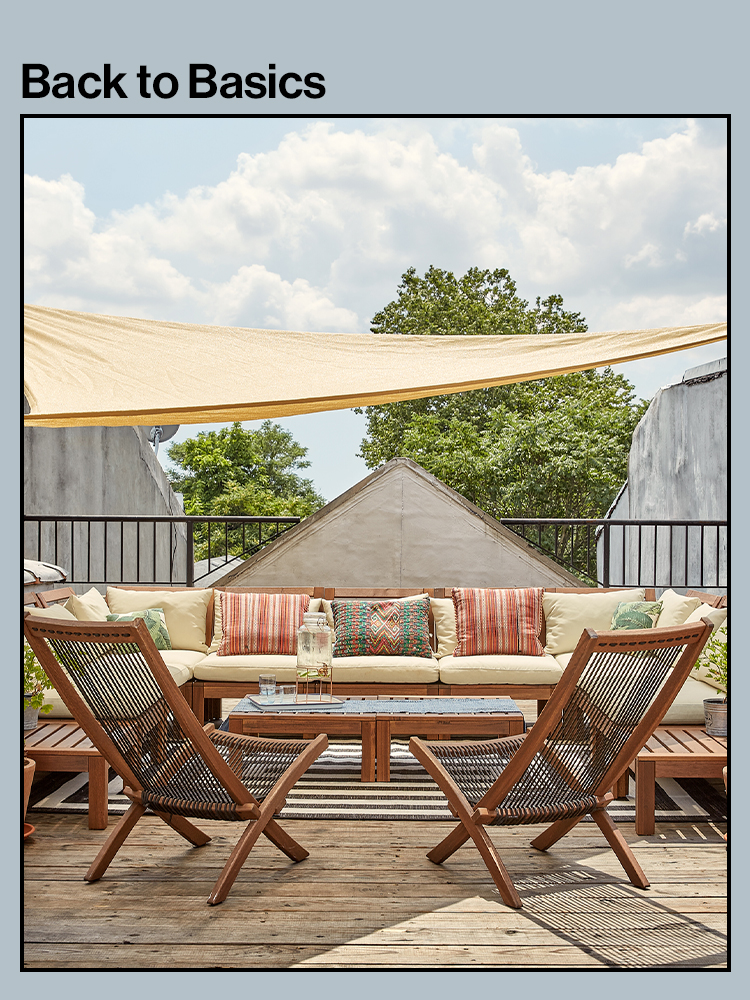We may earn revenue from the products available on this page and participate in affiliate programs.
If you and your family are on opposite ends of a tense deck-versus-patio debate, you’re not alone: David Steckel, home expert at online home services directory Thumbtack, says patio and deck remodels and additions are up 187 and 128 percent, respectively, over the past three months alone. So will you be grilling on your freshly painted deck or sipping iced tea beneath the umbrella of a patio dining set? Read on for our detailed breakdown of the differences between the two, including building materials, maintenance needs, placement, and, of course, cost.
What is a deck?

Decks are typically made from wood like cedar, ipe, or Trex, a composite that contains wood and plastic, explains Steckel. They’re usually located adjacent to the house (and not just anywhere in the backyard) and tend to be raised off the ground. Safety railings enclose the platforms, which can be accessed by stairs or a ramp. And with an average cost of $7,700, these elevated outdoor spaces are by far the more expensive option. Expect to spend anywhere from $4,080 to $11,300 total, or $30 to $60 per square foot. Of course, the final number will also depend on the deck style you choose. Among your options:
- Wraparound (a deck with more than one entry point)
- Attached (a L- or U-shaped space affixed directly to the home)
- Detached or floating (accessed by a walkway or path and separate from the main house structure)
- Rooftop (built on top of the home)
- Multitiered (a deck with various heights to accommodate unlevel ground)
The Pros and Cons of a Deck
The pros: Because decks are elevated, you can easily build on top of all types of terrain, whether uneven, hilly, ground, or a flat yard. Additionally, they’re completely customizable—think: upgrading a wood railing to modern metal with glass panes, adding stone columns around the perimeter, or building a gazebo. Once your deck is finished, prepare for your home value to increase thanks to the additional square footage and expansive new view.
The cons: If you’re impatient, the biggest downside is construction time, which could take anywhere from one to three weeks or longer depending on permits. Also, decks need long-term maintenance; it’s recommended to treat them to at least one annual deep cleaning (Steckel suggests a springtime schedule or when temperatures are relatively mild), plus a round of staining and sealing every couple of years. Also you’d be wise to budget for repairs like visible rotting planks and cracking or loose stairs or railings, which can cost between $250 and $1,200 on average. However, once your deck is finished, prepare for your home value to increase thanks to the additional square footage and expansive new view. “Stone is forever and wood does have a finite life expectancy,” Steckel notes of the patio and deck contrast, so keep this in mind when making your final decision.
What is a patio?

Patios are ground-level paved spaces that can be attached or detached from the home, Steckel explains. They can be concrete, stone, tile, or brick. A patio can cost anywhere from $500 to $8,000 ($5 to $50 per square foot), although the average project price comes in at around $3,620.
Patios generally fall into two camps: wet laid or dry laid. With the former, your chosen flooring is mortared to a concrete pad (at least 4 inches thick) atop a gravel substrate for drainage. Joints (aka gaps between the stone or brick) are filled in with grout. By contrast, the dry application doesn’t use mortar at all. Instead the contractor excavates the area, then adds between 6 and 8 inches of gravel, followed by about 3 to 4 inches of limestone screening (patio leveling material), sand, or a high-performance bedding like Sakrete Paver Base that doesn’t solidify, Steckel says. After the flooring is set, polymeric sand fills in the joints. Mind you, patios can also be built with pavers, rock, or pea gravel. They’re easy to maintain but require routine cleaning to prevent mildew.
The Pros and Cons of a Patio
The pros: Patios are built flush with the ground, so they don’t require safety railings. Also, a basic 10-by-10 gravel style can take as little as a week to install. Cleaning them is a cinch: simply sweep leaves and dirt away on a weekly basis, then once a year use a power washer to blast away built-up grime. (Psst: You can also remove stubborn stains from stone or concrete surfaces with a water-vinegar mixture.)
The cons: Homeowners with uneven land may run into some installation roadblocks, Steckel explains. Additionally, patio design tends to be more restrictive because you’re working with less space and a single level. Another thing to consider? Patios are prone to cracking. Despite concrete being a relatively sturdy material, issues with the supporting layer could compromise the overall build down the line. Routine patio repairs to address a crumbling surface, weather damage, or paver replacement can cost between $5 and $25 per square foot, although that’s on the low end.
For After It’s Built
